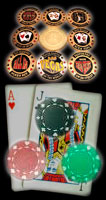Counting Methods of Calculating Probabilities
We can calculate the probabilities of various outcomes in card games by using mathematical counting methods.
We’ve already done some of that at various places in this book. The probability of an event can be calculated as a relative frequency.
For example, in the shuffle-the-deck-and-turn-a-card trials, the total number of possible outcomes is fifty-two.
There are fifty-two cards in the deck, and anyone of them could be the one turned over. If the event that we are interested in is that the card turned over.
If the event that we are interested in is that the card turned over is a black card, then we have twenty-six possible outcomes that correspond to the event.
The probability of the event is then twenty-six divided by fifty-two.That’s 0.5.
In Holdem we’re often interested in calculating the probabilities of hitting our outs on the next card. For example, in a gutshot straight draw on the flop, say the flop is 9 ![]() 5
5 ![]() 2
2 ![]() and we have 7
and we have 7 ![]() 8
8 ![]() .
.
We have four outs, any 6 makes a straight for us.What’s the probability of this happening? We need to count two things: the total number of possible outcomes and the number of those outcomes that makes our straight.
We’ve already counted the second of these, four cards will make your hand. The total number of possible cards that can be turned up on the next card is forty-seven.
That’s just the fifty-two cards in the deck minus the five cards that we know can’t be turned up (the three on the flop and the two in our hand).
Because we don’t know anyone else’s hand, we just consider all the other cards to still be in the deck.We only subtract out those cards that we specifically know can’t be turned up next.
Therefore, the probability of making our inside straight draw on the turn card is 4 ÷ 47 or about 0.085.Expressed another way, it’s about a one in twelve chance, or 8.5 percent.
How about the probability of making an inside straight in the next two cards?The probability that either the turn or the river card is a 6?
Before we look at that, we need to consider two rules of calculating probabilities of joint events.
By joint events I mean a trail that consists of two distinguishable events, in this case the turn card or the river card.
The first of these rules is called the addition rule. Whenever we want to know the probability of something occurring one way or another way, we can calculate the two probabilities separately and add them together if the two ways of occurring are mutually exclusive.
The addition poker rules is applicable whenever our statement of our two events uses the word “or” the turn or the river. The events need to be mutually exclusive.
We can’t add probabilities for two things that overlap.In the case of a 6 falling on the turn or the river, we have to be concerned with double counting those times that a 6 comes on both fall on the turn, then counted the ways a 6 could fall on the river and added them together, we would be counting some sequences of cards twice. (I’ll give you a way to avoid this in a minute.)
Mathematics of Poker / Other Books on Holdem / Poker and the Internet



